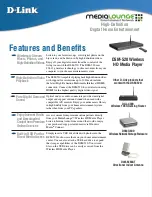
Page 9
Stream Buffer size, you typically
will not
have to change this again. The ASIO buffer size, however, may need to be increased or
lowered from time to time depending on the context of use.
Once you determine the lowest achievable buffer size,
you will typically have to double the size each time you double the sample rate,
but the effective latency will remain constant
. For example, if a system is capable of operating at a buffer size of 128 samples at 48
kHz, then for a 96 kHz project, the buffer size will likely need to be increased to 256 samples.
The third tab in the Hilo Control Panel opens the INFO page.
This page simply reveals the connected product (again Hilo), the
Revision of the LT-USB (its firmware version), serial number
and driver build.
2.5.1
Installation for Macintosh OS X
Hilo will operate as a Core Audio device under OS X automatically without any driver installation required. Core Audio is the
dominant audio driver model for OS X, and is used for media playback applications as well as Pro Audio applications.
Simply connect the USB cable from Hilo to your Mac OS X computer and Hilo will be immediately available for use. Please note that
Hilo does require OS X version 10.6.4 or above.
2.5.1.1
OSX Audio Applications
Hilo can be used as a playback device for most popular multimedia, home theater and pro audio applications. Some such applications
allow selection of specific playback devices. In these cases, a Lynx Hilo output device can be selected from the appropriate device
selection menu.
In cases where the playback software does not provide access to output
selections, the default output devices for the operating system will be
used. In OS X, the audio out default device can be established from
Applications > Utilities > Audio MIDI Setup.
When the Lynx Hilo is selected as the output sound device, channels
1&2 are active by default. In this state, audio will be sent to ALL Hilo
outputs simultaneously. If you wish to mute a stream to a particular
output, you can do that from the Output Mix Routing Page, as describe
in section 3.4.2 Output Mix Routing Page.
2.5.1.2
Controlling Latency by Changing the Buffer Size
Latency in an audio interface can be defined as the time required to process a sample from an application to the interface’s audio
output. A number of factors determine the achievable latency performance of a Hilo/LT-USB system: Processor speed; Operating
system; Sample rate; Number of utilized record or play channels; System efficiency; etc.














































